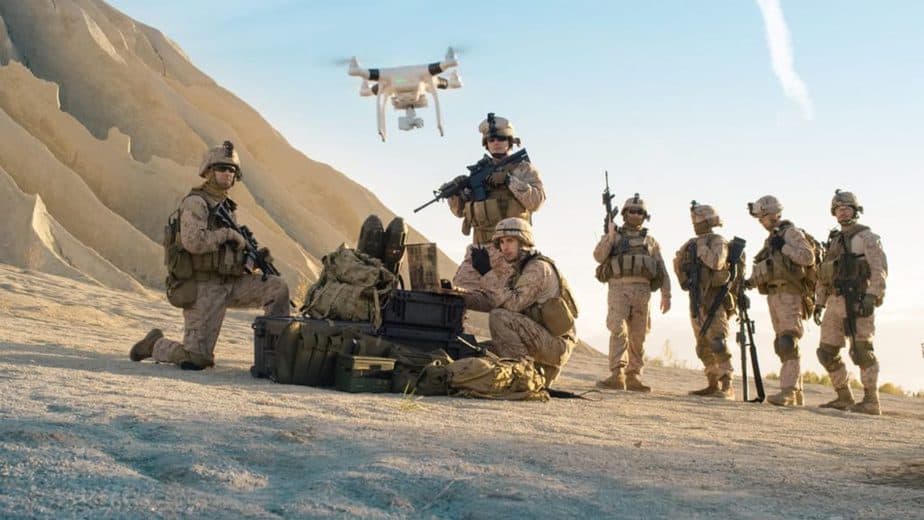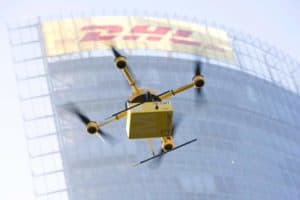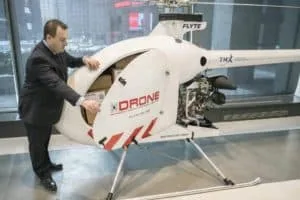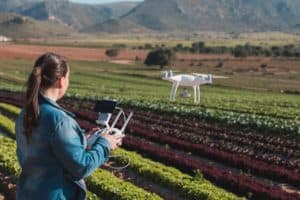Editor’s Note: On July 30, 2021, Draganfly uplisted to NASDAQ under the symbol “DPRO.”
Drones. We all have been hearing the promises of this technology for years. But the reality has been slow to materialize. Jeff Bezos said Amazon would be delivering packages via drone very soon. That was four years ago, and I'm still waiting for my packages to arrive from the sky like in those cool videos.
After seeing this year's Super Bowl halftime show, and the impressive light show put on by Intel, I felt like it was time to take a closer look at how far the technology has progressed and where drone technology can ultimately take us. You’ll be surprised!
First, let's look at the backstory on drone tech.
Drones, also known as unmanned aerial vehicles (UAV), are pilotless and non-crewed aircraft that are capable of flight either by remote control, through the use of computers, or increasingly using newly developed cloud-based artificial intelligence applications, or AI.
Early drone technology and components were costly and simply not available to the consumer markets.
The first drones were developed for the military, and were mostly used for reconnaissance and target practice. It was the US Navy that coined the term “drones” in 1936.
It wasn't until 1964 that drone technology became more sophisticated and saw its first combat action during the Vietnam War.
The US military officially confirmed that they had been utilizing UAV technology in Vietnam, stating that during the war more than 3,435 UAV missions were flown — of which about 554 were lost in combat.
In the years following the Vietnam War, interest in UAV technology, reconnaissance patrols and missions continued to grow.
With the terrorist attack on September 11, 2001, the US military unleashed a fully weaponized version of its winged UAV known as the Predator. The Predator drone would go on to be best known for its use in the CIA's covert wars over the past almost 20 years.[1]
Drones first appeared in the consumer market in DIY communities in 2007, the same year the first iPhone was launched. That is no coincidence, as many of the components used in smart phones have direct application in drone technology, e.g. sensors, microcontrollers, cameras and batteries. These components had become smaller, more efficient and cheaper.
In 2010, Parrot released the AR.Drone, one of the first mass market drones that sold over half a million units within its first 3 years.[2]
These drones were quickly mounted with a camera, allowing hobbyists to take pictures and videos from the sky. In January 2013, the hugely popular consumer drone, the Phantom, was released by Chinese company DJI. This release forever changed the landscape of consumer drones as they became easier to use and cheaper than ever before.
In 2016, DJI, still privately held, reported $1 billion in annual revenue.
Now the story really gets interesting...
Drone technology, both hardware and software, has now reached a tipping point. The first commercial applications are just starting to be rolled out.
Drones are used in real estate mapping and photography, the construction industry (AEC) adoption for onsite mapping and job site controls, use in agriculture for crop monitoring, fertilizer and pesticide applications, package delivery, military applications, search and rescue, border security, and most recently passenger transportation.
The list of drone applications continues to grow daily as the technology and innovations advance by leaps and bounds.
Quite simply the future of drones has arrived.
Goldman Sachs forecasts a $100 billion market opportunity for drones between now and 2020.[3]
Specialized military use will continue to be the largest market for the foreseeable future with an estimated $70 billion market share by 2020[4]

The market for commercial drones is expected to reach $13 billion by 2025.[5]
Furthermore, research and development for drones is projected to reach $4 billion globally by 2020, and revenue from drones is expected to reach up to $2.4 billion.[6]
Current drone technology has already surpassed manned aircraft in endurance, range, safety and cost efficiency — but research and development is far from over.

Quite frankly, the rapid adoption of drones, both commercial and consumer, has left governments scrambling to catch up with regulating them. The lack of regulations is what is currently holding back next stage commercial drone adoption.
In the US, the Federal Aviation Authority (FAA) has launched their Unmanned Aircraft System (UAS) Integration Pilot Program (IPP) working with state and local governments to participate in working on rewriting regulations regarding drones and their use.
The program aims to provide comprehensive solutions for a wide variety of issues, including advanced Universal Traffic Management (UTM), security procedures, anti-hacking protection, medical supply deliveries, as well as general commercial use.[7]
The video below opens to the FAA website (FAA.gov) and is worth a couple of minutes of your time. It quickly outlines what the FAA is currently working towards in regards to regulating airspace for drones in the US.
NASA is leading a multibillion-dollar UTM effort to develop a US airspace management system to manage drone traffic and keep drones and manned aircraft from colliding.[8]
While the US is playing catch-up, working on their version of drone regulations, other countries around the world are already using drones in real-world scenarios.
Take Iceland for example. They have already approved guidelines and have active point-to-point consumer delivery service in place.

The drone technology company Flytrex, in partnership with AHA, Iceland’s largest online marketplace, launched the world’s first operational on-demand urban drone delivery service back in August 2017.
The CEO of Flytrex, Yariv Bash, stressed that “this is a working system, not a one-off wonder.”[9]
In Tanzania and Rwanda, Zipline, a California-based logistics company, has been operating a blood delivery service since October 2016. It now transports 20% of the nation’s blood supply outside Kigali and announced plans to expand into Tanzania, where 68% of the country's 55 million-person population resides in rural areas.
When fully in place, Zipline will have four distribution centers across Tanzania offering a range of medical supplies. It will also make Zipline the largest drone delivery system in the world.[10]
Chinese courier company SF Holding Co. (Shenzen: 002352.SZ) says it has won a license to operate drones, opening up a new potential frontier for package delivery in the world’s second-largest economy.[11]

Drone Delivery Canada Corp. (TSX-V: FLT.V / OTC: TAKOF) is developing a drone delivery platform solution which is cost effective, highly scalable and will provide next generation logistic services to various market sectors including; retailers, service organizations and government agencies.
Currently the company is engaged with a number of pilot clients, working together to co-develop this innovative logistics delivery platform.
The EU is working on finalizing their version of drone regulations called U-Space. The UK is not far behind with their own automated drone tracking system set to roll out soon.
The rush to on-demand delivery has retailers scrambling for airborne delivery solutions. Target purchased Shipt for $550 million.[12] Alphabet is testing its own drone delivery program, Project Wing initiatives, in Australia. And last but not least, Amazon has Prime Air, which is still in development.

As mentioned above, by far the largest part of the drone market is military and security applications with an estimated $70 billion market share by 2020.[4]
While the Predator drones hunting down terrorists in far flung parts of the world get most of the press, I believe the story is more interesting with the smaller lighter nano-drones that will definitively tip the scales on the battlefield.
The US Army is actively testing a hand-held drone that will give field soldiers the capability to "see" over the horizon or in the window of that building just ahead. The drones are called Black Hornets, a system being developed by US-based Flir Systems (NASDAQ: FLIR). The drones were purchased under a $40 million contract announced earlier this year between the Army and FLIR Systems.[12]
The resulting drone can see day or night, record video or still images, and has a flight time of 25 minutes. Here’s a FLIR Systems video on the latest version, Black Hornet 3.
The service plans to award other transaction authority contracts this fiscal year (2019) to companies to provide enough systems for Army units to test and evaluate. The plan is to get the UAS into users’ hands at the beginning of fiscal 2020.
— Brig. Gen. Thomas Todd[13]
The adoption of drones by the military is sure to fuel further demand for drones and drone technology in the coming years.
There are three main investment opportunities in the drone space:
Drones
Chinese based DJI is the 800 pound gorilla in the consumer drone space. But several up-and-comers are looking for a piece of the space and developing innovative drones.
As the US-China trade war continues to heat up, the US Department of Homeland Security issued a warning of the dangers of Chinese-made drones. It is still too early to tell whether the US government will issue a ban as they did with communications chip maker Huawei. This is something to consider when doing your research. [14]
Companies such as Israeli drone-in-a-box, Airobotics; French tethered drone, Elistair; Swiss collision-proof drone, Flyability; American delivery drone station, Matternet; Canadian small and long endurance drone, SkyX; Dutch drone converting wind into green energy, Ampyx Power; Canadian holder of dozens of industry leading patents and robust software developer, Draganfly; among others. [15]
Drone Components and Sensors
In terms of sensors, there are embedded sensors (accelerometers, inertial measurement, tilt sensors, etc.) which improve the drone's stability and autonomy. Additional sensors are used to capture data for later analysis.
While a simple camera is used for photogrammetry (3D mapping), other applications require specific data and therefore, specific sensors like image, light, heat, sound and magnetic. For example, hyperspectral cameras measure the light reflected by plants for agriculture purposes to detect crop health, while thermal cameras are being used for search and rescue, surveillance or inspection purposes.

Drone Software and Artificial Intelligence (AI)
The software is critical in interpreting the data collected by the drone and transforming it into action points.
In the case of agriculture, the software can interpret hyperspectral data and provide information to the farmer to optimize fertilizer or pesticide distribution.
Other software companies like Pix4D focus on image processing to create a precise digital 3D model from aerial pictures and GPS information. SenSat enhances 3D models for the construction industry by improving the end-user experience specific to this market, integrating click-to-measure toolkits, team collaboration, CAD integration, etc.
Apart from data analysis, artificial intelligence (AI) sits at the core of drone advancements. Today’s advanced drone systems can already navigate tricky urban cityscapes (including skyscrapers and attacks), utilizing advanced AI to communicate with other drones to avoid collisions, and the technology continues to advance significantly.
Drone companies are also investing heavily in cybersecurity to prevent hackers from hijacking your delivery.
Flytrex, mentioned earlier, does not manufacture drones. Their core business is producing a cloud-based drone management system that allows the operator to communicate with the drone, enabling smartphones to track estimated times of arrival and delivery activation, integrate into the shipper’s logistics systems and communicate with the aviation regulatory agency.[16]
Many of the companies currently working in the drone space are still private, but I expect that to change as regulations become more drone-friendly. This will allow drones to literally take off and start working, thus attracting more investor money in the public markets.
Here are a few more companies I discovered during my research that you may want to keep an eye on and investigate further:
AeroVironment Inc. (NASDAQ: AVAV) designs, develops, produces, and supports small unmanned aircraft and fast charge systems for electric industrial vehicle batteries.
Ambarella, Inc. (NASDAQ: AMBA) supplies video chipsets and image processing solutions. Their image processing solutions are part of GoPro’s cameras, and they reportedly get about a third of their revenue from that relationship. As a leading provider of mobile video and HD technology, Ambarella certainly will have a place in the world of drones — with or without GoPro.
Parrot (OTC: PAOTF / FRA: P2W.F / PARIS: PARRO.PA) is the leading European group in the drone space. Parrot is the only group to be positioned across the entire value chain, from equipment to services and software.
The Parrot Group designs and engineers its products in Europe, mainly in France and Switzerland. It currently employs more than 500 people worldwide and makes the majority of its sales outside of France.
STMicroelectronics N.V. (NYSE: STM) is a Swiss tech company currently researching chips for 3-D printing and “Internet of Things” operations, as well as drones. STM has long been a leader in smartphone gyroscope technology for both Samsung Electronics Co. and Apple Inc. Simply put, the $7 billion company has a history of making big deals with big companies.
Sony Corp ADR (NYSE: SNE) manufactures drones primarily with cameras for retail sales. The company is also in the business of commercial drone manufacturing.
HEICO Corp (NYSE: HEI) manufactures aircraft and jet engine components. In 2017 the company acquired AeroAntenna Technology and Interface Displays & Controls — which has been helping to fuel growth.
Investors seeking to invest in a diversified portfolio of drone stocks can also look to the ETFMG Drone Economy Strategy ETF (NYSE ETF: IFLY) the first ETF dedicated to drone-focused stocks.
Drones and their advanced worldwide adoption have been accelerating at breakneck speed over the last couple of years. Governments around the world are scrambling to update flight regulations, and this in my opinion will be the tipping point to open up the potential for drones in our daily lives, e.g. further military applications, search and rescue operations, delivery services, agriculture use, construction survey, etc..
I believe drone software and AI will also help catapult drone companies into places we haven't even thought of yet. As drones become more autonomous, stronger, smaller, faster or more accurate, drones use cases will multiply exponentially for the next few years.
And who knows, maybe my package from Amazon will finally be delivered via drone this year!

MF Williams, Contributor
for Investors News Service
P.S. To discover more opportunities in the hottest sectors in North America, sign up now to the Financial News Now newsletter to get the latest updates and investment ideas directly in your inbox!
DISCLAIMER: Investing in any securities is highly speculative. Please be sure to always do your own due diligence before making any investment decisions. Read our full disclaimer here.
[1] https://www.redorbit.com/reference/the-history-of-drone-technology/, https://en.wikipedia.org/wiki/General_Atomics_MQ-1_Predator
[2] https://medium.com/c4-ventures/investment-opportunities-in-commercial-drones-76a45c0a563d
[3] https://www.goldmansachs.com/insights/technology-driving-innovation/drones/
[5] https://www.statista.com/topics/3601/commercial-uavs/
[6] https://www.investopedia.com/articles/markets/021116/4-best-drone-stocks-invest-2016-amba-eslt.asp
[7] https://www.forbes.com/sites/startupnationcentral/2018/04/10/drone-deliveries-are-no-longer-pie-in-the-sky/#14ea863d4188
[8] https://uavcoach.com/utm-drones/
[9] https://www.forbes.com/sites/stevebanker/2017/08/23/amazons-jeff-bezos-drone-prediction-was-far-too-optimistic/#705ca9061bd3
[10] https://www.forbes.com/sites/leifwalcutt/2017/08/24/zipline-is-launching-the-worlds-largest-drone-delivery-network-in-tanzania/#5344f120293b
[11] https://www.bloomberg.com/news/articles/2018-03-28/china-s-biggest-courier-firm-could-soon-deliver-parcels-by-drone
[12] https://www.popularmechanics.com/military/weapons/a27547136/us-army-drones-black-hornet/
[13] https://www.defensenews.com/land/2019/04/29/army-takes-another-stab-at-rucksack-portable-unmanned-aircraft/
[14] https://www.theverge.com/2019/5/21/18633744/dhs-alert-china-drones-dji-huawei
[15] https://www.cnbc.com/2018/03/29/how-bill-smith-founded-shipt-and-sold-it-to-target.html
[16] https://medium.com/c4-ventures/investment-opportunities-in-commercial-drones-76a45c0a563d